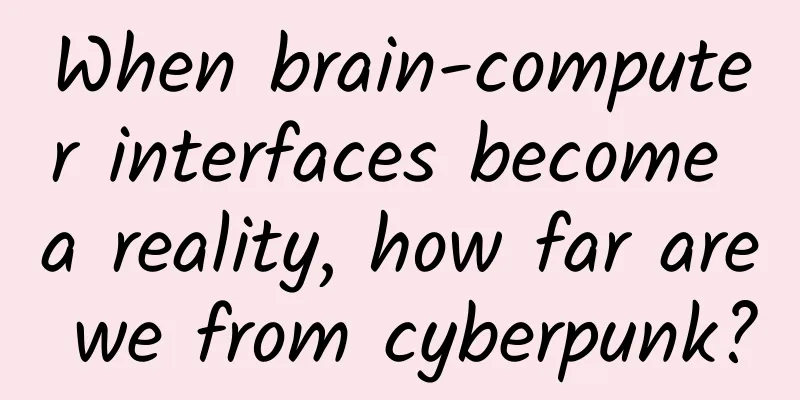When brain-computer interfaces become a reality, how far are we from cyberpunk?

|
Figure 1: Header image, source: Yunnan University Student Network In May this year, an American brain-computer interface company announced the launch of human clinical trials. Brain-computer interface technology has taken an important step towards the future. Perhaps one day we will really be able to enter the world of cyberpunk. 1. How does brain-computer interface achieve human-computer interconnection? Through a data cable, the human brain's consciousness can be uploaded to the Internet, and brain waves can be used to directly control technological products. This is the world depicted for us in science fiction works such as "Ghost in the Shell", "Cyberpunk 2077" and "The Matrix". Today, with the continuous development of brain-computer interface technology, we may be on the verge of realizing these science fiction plots. Figure 2: The pioneering work of cyberpunk, Do Androids Dream of Electric Sheep?, source: Game Time Forum Depending on the different ways in which brain-computer interfaces work, they can be divided into "invasive" brain-computer interfaces and "non-invasive" brain-computer interfaces. The main difference between the two is whether physical modification of the user is required. In addition, the broad definition of brain-computer interfaces also includes technological prosthetics in works such as "Battle Angel Alita" and "Cyberpunk 2077". Figure 3: The non-invasive interface in the movie Avatar, which achieves consciousness transfer through a hibernation capsule Figure 4: Invasive brain-computer interface in the movie "The Matrix", where the wires are directly inserted into the human body Brain-computer interface is not a new technology. Its development history can be traced back to World War II. Currently, brain-computer interface technology is mainly used in the medical field. The form of brain-computer interface widely known today comes from the concept proposed by Professor Jacques Davil in 1973: "It can allow the brain to be directly connected to an external machine. It allows computer electrical signals to be converted into brain electrical signals, thus realizing information exchange between the brain and the machine, and even forging information to deceive the human brain." In short, brain-computer interface technology obtains information from the brain by acquiring signals from the cortical layers of different brain regions, and further determines what you want to do. As a bridge between the brain and the computer, the brain-computer interface is essentially an input and output device. The first is output, which is to record the information sent by neurons, and the second is input, which is how to input information, that is, how to stimulate neurons. Figure 5: The front page of Jacques Davil’s brain-computer interface paper, source: Annual Reviews If we compare the brain to a stadium, then brain activity is equivalent to the sports events in the stadium. You can follow sports events through the broadcast outside the stadium, or judge the situation of the game through the cheers of the audience inside the stadium, but you can never get the details of the game. Imported non-invasive brain-computer interface technology is the equivalent of standing outside a sports stadium as a lookout, and can only monitor neural activity from the outside, meaning that many details are blurred. Using an invasive brain-computer interface is like walking directly into a stadium and watching the game in the audience, where you can directly access information from your nerves. As for how much information you get, it depends on how deep you go into the stadium. The scenery you can see from the corridor and from the first row of the audience will naturally be different. 2. Current Brain-Computer Interfaces Although the giants of brain-computer interface companies have conducted human clinical trials of brain-computer interfaces, this does not mean that this technology will make a huge leap in a short period of time. At present, brain-computer interfaces cannot connect everything as imaginatively as in science fiction works. They can only control electronic devices and help diagnose and recover from physical diseases. Figure 6: Hawking and his wheelchair, source: Tencent Figure 7: In the 2014 Brazil World Cup, brain-computer interface and exoskeleton technology helped a disabled teenager kick off the game. Source: Live video of the opening ceremony Figure 8: In 2020, Zhejiang University completed the first clinical translational research of implantable brain-computer interface in China. Source: Zhejiang University News Office 3. The Future of Brain-Computer Interfaces According to estimates by McKinsey Consulting, the potential market size of global brain-computer interface medical applications is expected to exceed US$40 billion in the next decade, which shows the economic potential of this technology. However, while brain-computer interfaces bring opportunities to society, they also bring anxiety. Neuromancer, published in 1984, tells the story of a hacker who uses a brain-computer interface to gain great power in the Internet world. The story depicts people's infinite yearning for future technological life, as well as their infinite concerns about the potential threats posed by technology. In any case, brain-computer interface is still the trend of the future, and it may become another far-reaching technological revolution since the invention of computers. As for what kind of future brain-computer interface will lead to, let us wait and see. Figure 9: Concept map of Neuromancer, source: Steam References [1] Artificial ion neurons can be used for future electronic memory[N]. Zhang Mengran. Science and Technology Daily. 2021-08-09 (004). [2] Brain connects the future: Has the brain-computer interface reached an explosive inflection point? [N]. Tao Li. 21st Century Business Herald. 2022-09-09 (012). [3] Brain-computer interface: How far is it from turning dreams into reality? [N]. Xu Weibing. China Economic Times. 2022-09-16 (002). END Source: Global News, Zhihu Nature magazine, Annual Reviews, Tencent News Author: Tang Yu Communication University of China Editor: Guru |
<<: A devastating "planet killer" may hit the earth. Can humanity escape the catastrophe?
>>: Scientific Expedition Diary: A Day “Going to Sea” in the Inland
Recommend
After Android and iOS, the third largest mobile system reappears
Google is still keeping mum on its intentions to ...
The product logic and marketing strategy behind emerging brands
At present, emerging brands are developing at an ...
How to run a training camp from 0 to 1?
Recently, I have just finished a training camp fo...
How much does it cost to customize the Yanbian lighting mini program? What is the price for customizing Yanbian lighting fixtures through the mini program?
The mini program provides convenience for publici...
360 Children's Watch 3S Preview: A Positioning Device for Children's Wrists
While you are still considering whether to buy a ...
What does the Klein bottle that is never full look like? | Expo Daily
What does a Klein bottle that is never full look ...
In an arena where monetization is difficult, how do these self-media get tens of millions of exposures?
It is understood that at present, when most conte...
Ren Zhengfei interview full text: There will be no chip supply cuts, don't incite national sentiment, my family also uses Apple, I've been married twice
[[265886]] On May 15, the Bureau of Industry and ...
How did Chinese tea conquer the world?
No matter what time Have a cup of tea first Whene...
The cheap 618 and fake orgasm
A brain teaser, what ads have you seen the most r...
Like an alchemy furnace! The Inner Mongolia volcano can "spray" Ulan Hada and "spit" agate!
The Ulan Hada volcanic group is located in Chahar...
How do Internet finance products motivate users? Share 3 tips!
For an Internet finance product, user incentives ...
What is the core of information flow? Social content!
Don't use bidding thinking to place informati...
How far away is Betelgeuse, the famously doomed star?
How to measure the distance from Betelgeuse to Ea...
Mayu advertising placement, Mayu advertising display forms
Mayu was founded in 2013 and currently has over 3...









